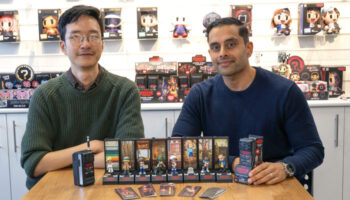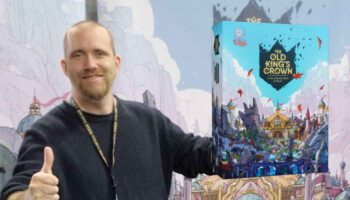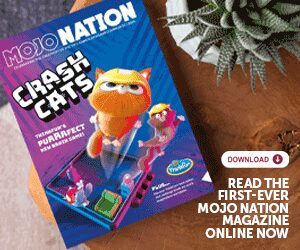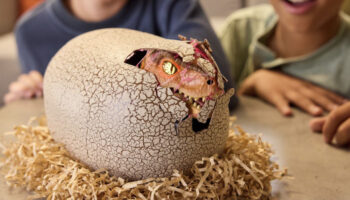Gavin Waxkirsh talks GW Development, Camden Games – and the origins of Polaroid: The Game

Gavin, let’s start at the beginning. How did you come to work in games, and was it always on the cards?
It wasn’t always going to be toys and games, but it was always one of the things that I wanted to do. I was always making games as a kid, but career-wise, I was looking at advertising or working in film – and I tried all of them really. I was also into theatre design and worked in the theatre too. But underneath it all, I was looking to get an opportunity in games – and that was actually the hardest of all the areas to get a job in. At the time, how did you get into games and toys? You’d try calling up Waddingtons, Spears or Milton Bradley. And that’s it. And really, how many jobs do they have available? So yes, that was actually the toughest thing to break into.
And what was your first gig in toys and games?
It came via Roger Ford of NPD Toys. He introduced me to John Reynolds at Spears who at the time was looking for someone. I walked in there and thought: ‘Great – I’ve got to create games’ and I started inventing. After presenting a few concepts day one, they were like: ‘No, no, that’s not what we do in R&D….You’ve got to develop the games and make them ready for production’. So that’s where I started learning about the production side of things.
So I shelved my own ideas, and that same week I started meeting inventors. That’s when I clocked: ‘Oh…these are inventors, and I’m doing the development.’ But the idea of creating my own games never went away.
How useful was that early inventor engagement in relation to how you now collaborate with inventors at GW Development and Camden Games?
It was great – a bit of a crash course. And we were never into hanging on to an idea – I learnt quickly the value of a fast no to inventors. And always a polite no with some suggestions too! I was working there with great people like Jim Harrison, Paul Laing, John Reynolds… And I still work with Jim to this day. We’ve created projects like the Polaroid game together.
Jumping forward to GW Development. What led you to launch that?
After Spears – which got taken over by Mattel – I then worked at Vivid, and a number of toy companies after that. I also ended up doing some part-time development and thought: ‘I might as well start trying to license the ideas I had’. So I packaged them up and the first sold through a company I was working with called All-In-One Products. They took a licence for a concept I developed with Francis Dufort, who is also an inventor, and sold it to Goliath.
I started working with other inventors too, collaborating and creating new ideas together. That was interesting, but every time I licensed an idea, the company was interested in my opinion about cost engineering it or packaging it. So, in the end, I was actually doing the development role as part of the inventing role! So that’s where GW Development started. It was originally about licensing ideas – and expanded to cover development work.
It feels like you cover a lot of different areas as GW Development. What are some core aspects that you help clients with?
We see ourselves more as producers than anything – more than just R&D or production or any of those individual elements. We have a great team in the UK, Hong Kong and China all collaborating on a project together.
We look at how we can improve the product and packaging to suit the distribution channels, and the right marketing, to make a product successful and to draw attention. And that applies if we’re developing a concept with an inventor or working directly with a games company however big or small. It’s the same approach. We’re very much about looking how to add value and how to come up with creative solutions to problems.
I also wanted to ask you about Camden Games! What led you to launch your own games publisher?
Like a lot of publishers, Camden Games came out of Covid. We’d had success doing a lot of FOB production on our own ideas, like our first game Igloo Mania, which launched into 23 different countries. We wondered how this would work without retail and how much more important grass roots and internet marketing would become for distributors. We’re actually re-launching Igloo Mania in new packaging this year. And because we’re doing it ourselves as Camden Games, we can give it the time it needs to be successful.

And is Igloo Mania indicative of what makes a game suitable for Camden Games?
We tend to do products that use unique components that couldn’t be interchangeable with another game. Igloo Mania is a great example of that, as is our pear-shaped Pear Shaped game! That’s a rocking pear timer – and it’s intrinsic to how that game plays. We’ll often get card games in and we’ll think about how we can add a component to bolster the gameplay. It can also help a game look a bit different and boost its impact on social media. The main thing with Camden Games is we like to give games a long-term grassroots approach that maybe another publisher or distributor wouldn’t have the time for.

You were nominated at this year’s Play Creators Awards – along with your co-designers Jim Harrison and Brooke Foster – for Polaroid: The Game. How did that concept come about? And was the Polaroid licence always attached?
It was an interesting one. It was an idea from years and years ago. We were inspired by the memory technique that people use when counting cards or memorizing the phone directory – which sounds very boring but is actually quite fun! It’s where you create unusual connections between two things that helps you remember the order. That was the spring board for a game where players memorise those connections together. Players had to recall a sequence of images by remembering the stories players made up to link them.
The question was then, how do we sell that idea? No one wanted another memory game! So it became more of a storytelling game, but that didn’t work. And then we went back to images themselves, and how they are tied to memories and stories – and Polaroid became the ideal licence. Fuel for Fun met the owners of the brand and showed them the game concept, and they liked it. Within a year, it became Polaroid: The Game. We even changed the card size to replicate the actual Polaroid size, which makes a big difference. It also means that players can add their own Polaroids to the game, which is a nice touch.

What fuels your creativity? What helps you have ideas?
I’d say working with other people – chucking ideas backwards and forwards is always key. And problem-solving is the other big one – that’s where we end up having the most creative discussions, whether we’re finding a solution for a mechanism, or packaging, or tariffs –there’s always all sorts of things you have to deal with.
I worked in the ad industry for a while and as a creative I had to come up with ideas – but that was a very linear creativity. With toys and games, it’s a much broader approach to creativity and I love that.
And what kills creativity for you?
I don’t think anything kills creativity if you can make something fun! If something feels like a chore, then making it fun forces you to see it from a completely different perspective – and that can fuel creativity.
Last question! What do you think is the most underrated item you’ve worked on?
Hmm… I really loved Pancake Monster – it’s an action game that eats the kid playing! It’s great fun. It was developed from a concept that I worked on whilst at Ooba Toys, and was a pretty complex challenge, but I wanted to crack it. And we did!

A friend of mine was working at Hensons and he helped create the character, and as a game it’s got the potential of playing it in lots of different ways. It’s a great product.
Absolutely. Gavin, a huge thanks again for taking time out to chat.
–
To stay in the loop with the latest news, interviews and features from the world of toy and game design, sign up to our weekly newsletter here
























